Site NE34
Property: Rutherglen Research Institute.
Paddock #: E
Australian Soil Classification: Ferric, Eutrophic, Grey CHROMOSOL.
Northcote Factual Key: Dy 3.4
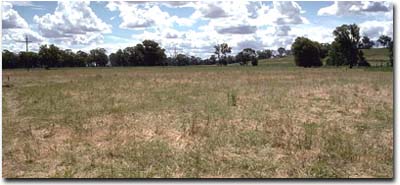 Site NE34 Landscape |
Soil Profile Morphology:
| Surface Soil | 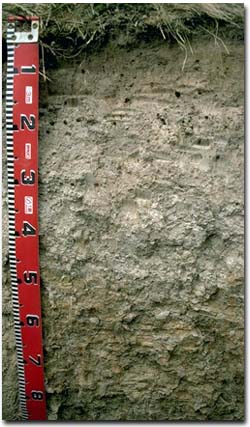 Site NE34 Profile | ||
| A1 | 0-15 cm | Pale brown (10YR6/3); silty clay loam; weak coarse blocky structure; some rusty root channel mottling present; pH 4.7; sharp change to: | |
| A21 | 15-25 cm | Light yellowish brown (10YR6/4) conspicuously bleached (10YR8/2d); silty loam; contains many (20 - 30%) ferromanganiferous nodules; pH 5.2: | |
| A22 | 25-40 cm | Light yellowish brown (10YR6/4) conspicuously bleached (10YR8/2d); silty clay loam; weak coarse blocky structure; contains a few (5 -10%) ferromanganiferous nodules; pH 6.0; sharp and wavy change to: | |
| Subsoil | |||
| B21 | 40-60 cm | Pale brown (10YR6/3) with strong brown (7.5YR5/6) and dark red (2/5YR4/8) mottles; medium clay; strong coarse blocky structure; pH 5.6. | |
Key Profile Features:
- Conspicuously bleached subsurface (A2) horizon.
- Strong texture contrast between surface (A) horizons (< 23% clay) and subsoil (B21) horizon (50 % clay).
Soil Profile Characteristics:
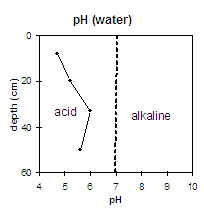 | The surface (A1) horizon is very strongly acid. The subsurface (A2) horizons are strongly acid, becoming moderately acid. The upper subsoil is moderately acid. | 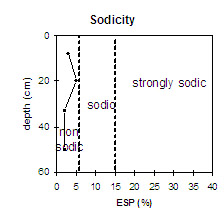 | The upper soil profile is non-sodic throughout. |
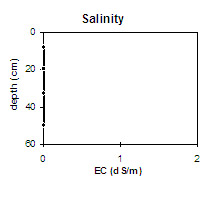 | Soluble salt levels are very low throughout the profile. | 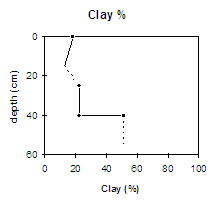 | The clay percentage increases significantly at the A/B horizon interface. |
Horizon | Horizon Depth (cm) | pH (water) | pH (CaCl2) | EC 1:5 | Exchangeable Cations | Exchangeable Aluminium mg/kg | Field Capacity pF 2.5 | Wilting Point pF 4.2 | Coarse Sand (0.2 - 2.0 mm) | Fine Sand (0.02 -0.2 mm) | Silt (0.002 -0.02 mm) | Clay (<0.002 mm) | |||
Ca | Mg | K | Na | ||||||||||||
meq/100g | |||||||||||||||
A1 | 0-15 | 4.7 | 4.1 | <0.05 | 1.2 | 0.23 | 0.16 | <0.05 | 94 | 22.6 | 5.6 | 1.7 | 45.3 | 37.0 | 18.0 |
B21 | 15-25 | 5.2 | 4.4 | <0.05 | 0.79 | 0.17 | 0.11 | <0.05 | 23 | 3.7 | 48.5 | 38.0 | 13.0 | ||
B22 | 25-40 | 6.0 | 5.0 | <0.05 | 2.2 | 0.93 | 0.14 | <0.05 | 1.3 | 46.7 | 34.5 | 22.5 | |||
B23 | 40-60 | 5.6 | 4.7 | <0.05 | 5.9 | 4.8 | 0.43 | 0.22 | 0.8 | 30.2 | 21.0 | 51.0 | |||
Management Considerations:
Surface (A) Horizons
- The surface soil has a very high fine sand and silt content (i.e. 82 %). Organic matter is therefore important for maintaining soil aggregation.
- The strongly acid surface soil indicates that aluminium and manganese toxicity may occur. The level of exchangeable aluminium measured in the laboratory (94 mg/kg) may result in some restriction to the growth of highly aluminium sensitive species e.g. lucerne, phalaris, barley and some wheat varieties. Raising the pH level of the surface soil will help reduce aluminium toxicity. A pH/aluminium test on a bulked sample taken from across the paddock would be most appropriate to determine how much lime is needed to raise pH levels.
- Deficiencies in molybdenum, calcium and potassium may also occur in strongly acid soil.
- The upper subsoil is non-sodic.


